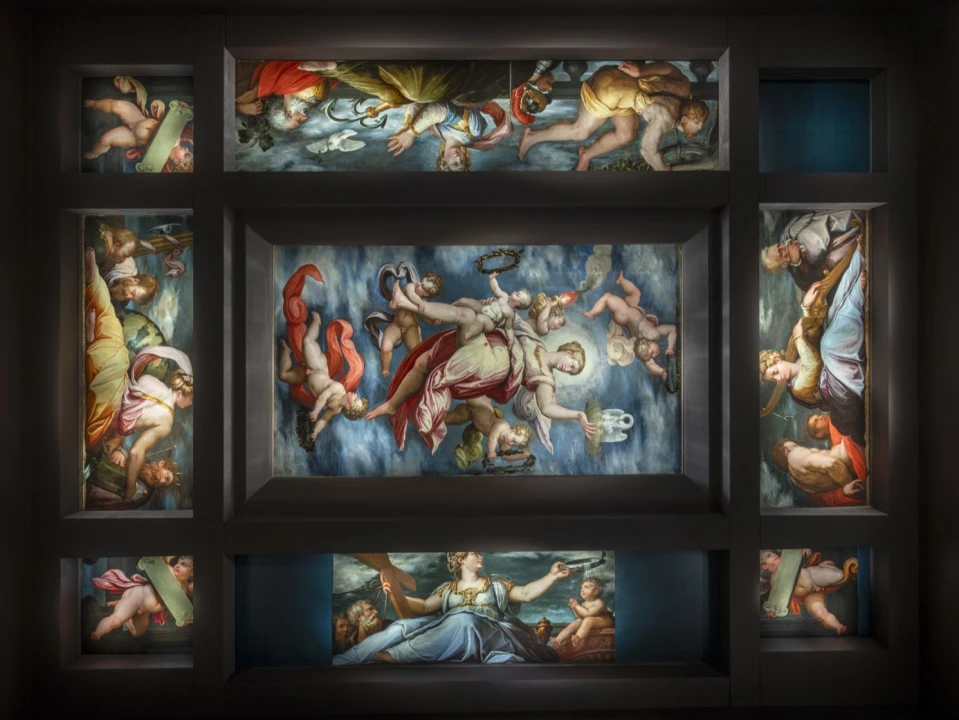After nearly 500 years, Giorgio Vasari's magnificent ceiling from Palazzo Corner Spinelli in Venice has been fully restored and is once again on public display. This Renaissance jewel has been painstakingly reassembled after its panels were scattered among private collectors and museums at the end of the 18th century.
For the past 40 years, the Italian government has been working to acquire the dispersed panels and return them to Venice. Now, all eight panels have been collected at the Gallerie dell'Accademia, where they have been reunited for the first time. The restored ceiling will become a permanent part of the museum's collection, showcased in a dedicated room.
Marking the 450th anniversary of Vasari's death, this Venetian masterpiece by the renowned Tuscan painter and architect is now displayed in all its glory. The ceiling's five main panels depict Allegories of Virtues, with Charity at the center, surrounded by Faith, Hope, Justice, and Patience. The corner sections feature three cherubs holding tablets, with the fourth unfortunately lost to time.
This restoration not only brings a lost masterpiece back to life but also highlights the ongoing efforts to preserve and showcase Italy's rich artistic legacy for future generations.
In 1541, a 30-year-old Giorgio Vasari received a prestigious commission in Venice. He was tasked with painting the coffered ceiling of the "camera nova" (new room) in the palace recently acquired by Giovanni Corner on the Grand Canal. This opportunity would lead to the creation of a Renaissance masterpiece that would captivate art enthusiasts for centuries to come.
Vasari's composition was a marvel of its time, featuring nine distinct compartments - five representing Virtues and four depicting Putti. In total, these painted panels covered an impressive twelve square meters.
The centerpiece of this grand work was the allegory of Charity, rising majestically in the middle. Surrounding it, in a captivating interplay of gazes, were Hope and Faith on the longer sides, with Patience and Justice adorning the shorter sides.
In a departure from the classical theme of the Triumph of Virtues, Vasari introduced his own artistic innovations. For each of the five main panels, he paired the central virtue with two contrasting examples: 1. A positive example that reinforced and expressed the concept of the virtue. 2. A negative example that stood in opposition to the virtue.
This juxtaposition added depth and complexity to the traditional allegorical representation, showcasing Vasari's creative genius.
The unity of this magnificent work was not destined to last. Around the mid-18th century, the panels were removed from the ceiling of Palazzo Corner-Spinelli, marking the beginning of a long and fragmented journey.
By the end of the 18th century, the ceiling's components were scattered, finding their way into various private collections across Italy and beyond. During this period of dispersal, some panels underwent significant alterations. The panels depicting Faith and Hope were reduced in size. From the Allegory of Hope, a new, independent subject emerged: the so-called "Suicide of Judas."
The "Suicide of Judas" fragment played a crucial role in the ceiling's eventual reunification. In 1980, it became the first piece to be repurchased by the Italian State. Initially, it was destined for the Vasari House Museum in Arezzo, as its connection to the Corner house complex in Venice was not yet recognized.
This acquisition marked the beginning of a decades-long effort to reunite the scattered pieces of Vasari's Venetian masterpiece, a testament to Italy's commitment to preserving its rich artistic heritage.
Chronology of Acquisitions
1987: The slow but steady acquisition of the ceiling compartments began. The Italian State purchased the Allegory of Justice, Allegory of Patience, and two Putti with Tablets, all destined for the Gallerie dell'Accademia's collection.
2002: Another Putto with Tablet and the compartment featuring the Allegory of Charity were acquired.
2013: The Allegory of Faith was purchased in London.
2017: The acquisition of the final major fragment, the Allegory of Hope, was completed.
As of now, three pieces remain missing: - The fourth Putto with Tablet and two fragments cut from the compartment with the Allegory of Faith




